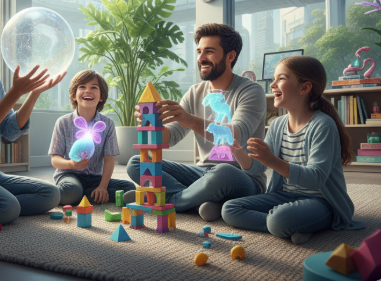A New Parenting Playbook for the Age of AI

Our kids will have relationships with AI. It’s our job to teach them what that means.
As a parent and a technologist, I’ve spent countless hours in the familiar trenches of the screen time war. The endless negotiation over “just one more video,” the anxiety about content filters, the debate over the right age for a smartphone — it’s a modern parenting rite of passage.
But lately, I’ve realized we’re fighting yesterday’s battle. The paradigm has already shifted beneath our feet.
The real conversation we need to have is no longer just about managing consumption, but about modeling and guiding relationships. Our children are the first generation to grow up in a world where AI is not just a tool, but an active participant in their lives — a patient tutor, an endlessly creative partner, and, for better or worse, a form of companion.
When your child’s favorite app isn’t just a game, but a character that remembers their birthday, learns their preferences, and talks back with evolving complexity, the old rules of screen time become woefully inadequate. We are moving from a world of passive consumption to one of active collaboration with technology.
This requires a fundamental update to our parenting playbook. We must evolve from being monitors of screen time to being guides for healthy digital relationships. Here’s where we can start.
1. The New Digital Literacy: “How Does It Work?”
For the last decade, digital literacy meant teaching kids to spot “fake news” or recognize an online ad. That’s still important, but it’s the bare minimum. The new literacy is about understanding the very nature of AI.
We need to give our children the mental models to be curious, critical navigators of their world. This means equipping them to ask deeper questions:
Is this a person or a program? Helping them understand the difference between a human on the other side of the screen and a large language model designed to emulate one is a foundational skill.
Where does it get its information? This simple question introduces the concept that AI doesn’t “know” things; it processes vast amounts of data created by people.
Does it have feelings? This is a crucial one. We can explain that while an AI might say it’s happy or sad, it’s using patterns in language it has learned. This isn’t to diminish the magic, but to teach them the difference between simulated emotion and true empathy.
What was the goal of the person who created this? This is the ultimate critical thinking skill. Was the AI designed to help, to sell, to entertain? Understanding intent is the key to true digital wisdom.
2. The Digital Sandbox: Practicing Empathy with AI
The way our children speak to Alexa or Google Assistant might be more important than we think. While we know the machine has no feelings, the habits of interaction are very real.
When a child barks commands at a voice assistant versus saying “please” and “thank you,” they are practicing a mode of communication. This presents a powerful, low-stakes opportunity to discuss respect, patience, and how we choose to engage with the world.
We can frame these interactions as a digital sandbox — a safe place to model the social and emotional skills we want them to carry into their human relationships. It’s a chance to explain that while the AI doesn’t care how we speak to it, we do, because it reflects the kind of people we want to be.
3. The Ultimate Upgrade: From Consumers to Creators
For too long, our children’s relationship with technology has been defined by consumption. They watch videos, play games, and scroll through feeds. The true promise of this new wave of AI is its power to flip that script. It’s the greatest creative toolkit ever invented.
Our role as parents is to help them see technology as a workshop, not just a window. We can reframe their entire relationship with these tools by encouraging active creation.
Instead of just watching, we can ask:
“What can we build with this today?”
“Let’s co-write a story. You come up with the hero, and we’ll ask the AI to help us imagine a world for them.”
“You drew an amazing monster! Let’s describe it to the AI and see what kind of a home it would live in.”
This simple shift encourages problem-solving, creativity, and agency. It positions them as the directors of the technology, not the other way around.
The World They Will Build
Raising a generation to thrive in an AI-native world isn’t about fear or restriction. It’s about preparation, open dialogue, and mindful engagement. It’s about giving them the framework to build a future where technology serves human curiosity, creativity, and connection.
The conversation is just beginning, and none of us have all the answers. But by shifting our focus from the clock on the wall to the quality of the interaction, we can raise a generation of mindful, discerning, and empowered digital citizens. They are, after all, the ones who will inherit this world — and build the next version of it.